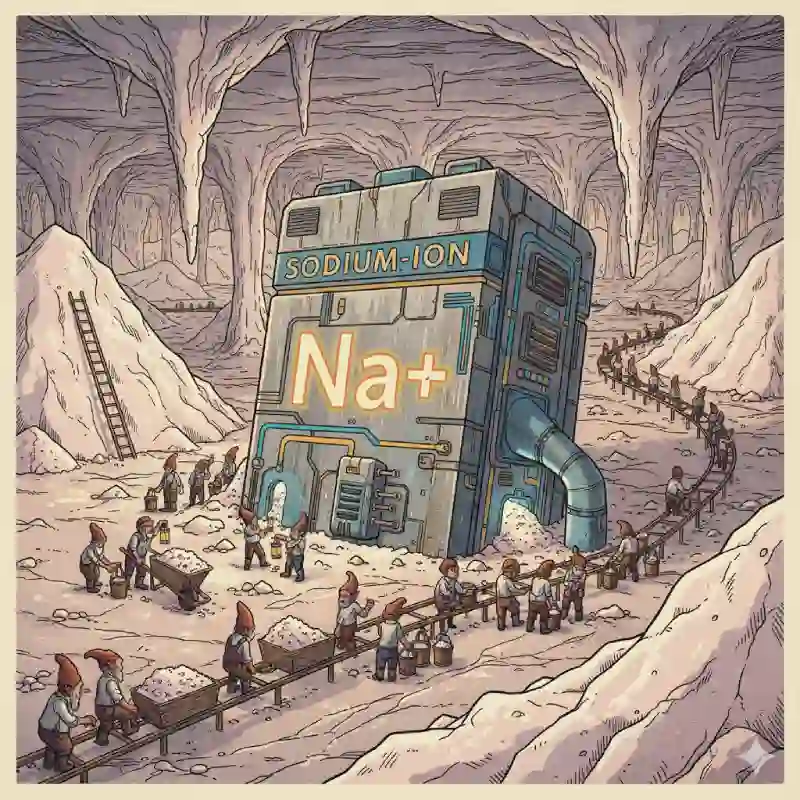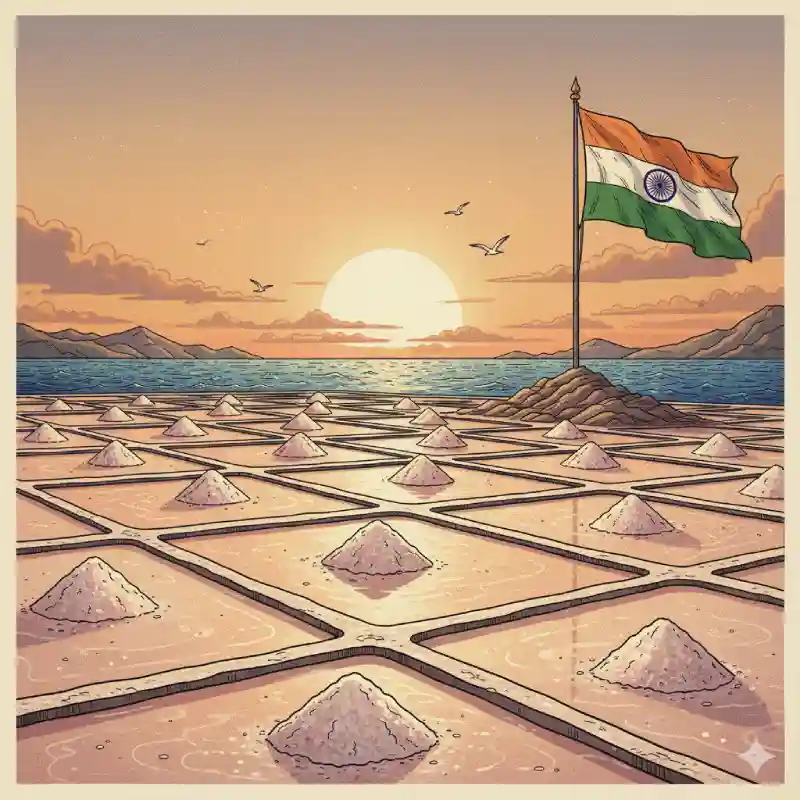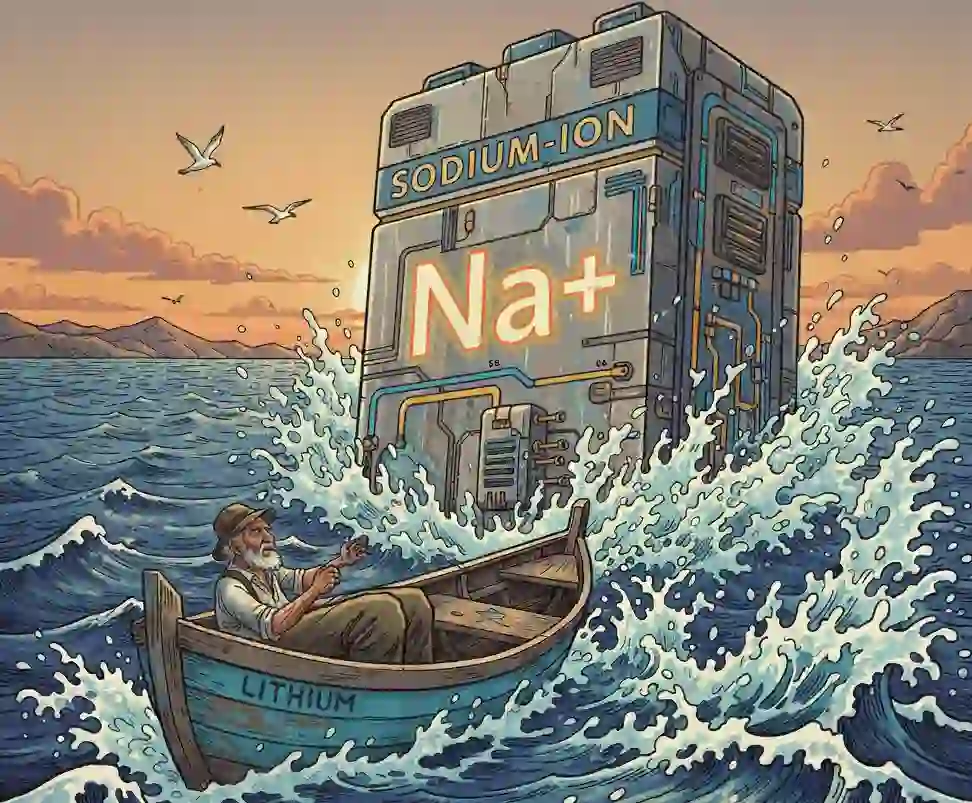A new sodium-ion battery promises to make electric vehicles safer, cheaper, and greener, and could help countries like India cut their dependence on costly lithium imports.
India’s growing hunger for energy storage has long run into one stubborn obstacle: lithium. Pricey, scarce, and mostly imported, it’s the Achilles’ heel of the EV and solar boom. But now, sodium, a far cheaper and more abundant element, is stepping into the spotlight.
A research group at the University of Surrey, has come up with a fresh take on sodium-ion batteries that could see them outlast and outperform lithium batteries in the near future. Their approach uses a liquid electrolyte that stays stable and non-flammable even at room temperature, revolutionizing both safety and cost.
Additionally, Alsym Energy, a US based battery developer has officially announced it’s new Na-series sodium ion batteries, with the stationary engine storage market as its primary customers.
From the Salt mine to the Grid

Unlike lithium-ion batteries, sodium-ion technology uses materials that are both non-toxic and easy to source; sodium is found in table salt, which is abundant in nature. The Surrey team’s innovation lies in a material called Nanostructured Sodium Vanadate Hydrate (NVOH) and a process of “not removing the water that it naturally contains.”
Traditional sodium cells have struggled with low energy density, meaning they store less power per kilogram. But this new design reportedly achieves densities approaching those of mid-tier lithium cells, while maintaining thermal stability for 400 charge cycles. Pair that with a fraction of the material cost, and you start seeing why governments and automakers are taking notice.
A sodium-based system could finally make large-scale energy storage affordable for rural India, where cost still keeps solar microgrids out of reach.
Mass production is already underway. Alsym Energy, based in Massachusetts, is launching pilot production lines and has secured strategic investment from India’s Tata Limited. Manufacturing plans, however, remain U.S-centric, and direct Indian production ties are not yet detailed. Their battery avoids using lithium, cobalt, or nickel entirely, a major win for sustainability and supply-chain independence.
Phys.org reports and studies suggest that, given time, the Surrey cell design could even outperform early lithium batteries in charge retention. Beyond EVs, the tech could make it a lot cheaper to store excess power from solar and wind farms. Imagine a power system where villages store daytime solar output in salt-based batteries, then release it after sunset. For countries betting on clean energy, sodium could quietly become the backbone of the transition.
Aatmanirbhar ambitions and global ripples

For India, in particular, the timing couldn’t be better. The government has been heavily investing in the National Energy Storage Mission. Put that together with the Aatmanirbhar Bharat initiative for homegrown battery ecosystems, and sodium-ion tech just fits into the picture perfectly. Researchers at IITs and BHEL are already testing indigenous variants tailored for tropical climates.
The biggest selling point, however, is without a doubt, resource independence, since India has vast salt reserves but minimal lithium deposits. Sodium-based manufacturing would free the country from China’s lithium grip while creating a new wave of green-tech jobs. The shift could even redefine EV pricing, as sodium-ion cells slash battery pack costs by up to 40 percent. As other nations race to secure lithium mines, India might just leapfrog ahead, not by mining harder, but by thinking smarter.
It’s important to note that the broader story here isn’t just about one battery chemistry replacing another; it’s about a possible rewiring of the global energy hierarchy, if everything goes to plan, of course. While Lithium took decades to dominate, its cost, scarcity, and environmental toll make it a prime target for breakthroughs in the chemistry of batteries.
With some reports suggesting these batteries work well at even sub-zero temperatures, if this new technology proves itself in large-scale tests, it could change life not just in India, but across the globe, Third-world countries with access to the sea could effectively skip a generation of dependence and move straight into a cleaner, more self-reliant energy phase. Additionally, Sodium’s abundance, safety, and compatibility with renewable grids make it a rare “win-win” in an industry usually defined by trade-offs.
White Gold
If lithium was the “white gold” of the 2010s, sodium could be the new white gold of the 2030s. Some may call it hype, while others refer to it simply as chemistry catching up to economics. While the Surrey breakthrough has by no means made lithium obsolete, it does crack open a long-locked door, especially for India, where we have Sodium in abundance, as well as an advanced pharmaceutical sector capable of manufacturing the exact compounds required, at scale.
What makes it interesting is that there actually was a time during the Medieval period when salt was referred to as white gold. It’s where the saying “worth its weight in salt” came from, as well as the word Salary, which literally means “salt money,” a term used for wages by Roman soldiers.
In case you missed:
- China Builds World’s Largest Neuromorphic Supercomputer: Darwin Monkey
- New Study Proves Gold Grows on Trees: What it means and why India should pay attention!
- Toyota’s Liquid Hydrogen-Powered “GR H2” Race Cars
- One Chip to Rule Them All: The 6G Chip at 100 Gbps!
- CDs are making a comeback, on a petabyte-scale capacity!
- From Earth to Orbit: Data Centers are Heading Out to Space!
- India, iPhones, China & Trump: The Foxconn Story!
- DeepSeek’s AI Revolution: Creating an Entire AI Ecosystem
- Lab-Grown Brain Thinks It’s a Butterfly: Proof We’re in a Simulation?
- India’s first Aatmanirbhar Chip Fab: TATA leads the way!










